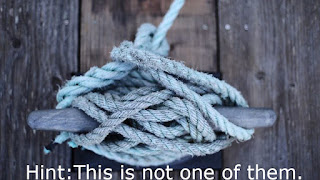Six Nautical Knots Every Boater Should Know
So here we are again, sitting at home looking out the window as the wind blows the leaves around the yard. Maybe even some of us are looking at snow. We are wondering how another boating season has gone by so quickly. For those of you who live in places like Miami or Phoenix this does not apply to you, so I guess you can skip this paragraph and move to the next one. For the rest of us, we are once again wondering how to pass the winter months as landlubbers. Here is a suggestion: Learn how to tie some knots.
Here are six of the most useful knots for boaters, what you should use them for, and how to tie them.
Bowline
This is definitely one of the most versatile knots you can have in your arsenal. I have heard a lot of boaters claim that if you only learn one knot it should be the bowline. Some call it the life saver because it is taught to sailors as the knot to use to tie themselves to a lifeline should they fall overboard but is has an almost unlimited number of uses.
Characteristics – Does not come loose on its own but easily removed by hand. Loop remains the same size even under strain.
Types of uses – towing, lifelines or any other connection that requires a strong hold.
Cleat Hitch
This is one of the most common knots you will find on a boat. Walk up and down any boat dock and you will see many of these. Unfortunately, you also see that some boaters have not quite mastered the art of securing their boat to a dock properly. A cleat hitch is a quick and easy way to secure a line to a dock or boat cleat with minimal fuss or problems.
Characteristics – Does not come loose on its own but can easily be removed by hand. Designed specifically to tie to boat or dock cleats.
Types of uses – Attaching a line to a cleat such as when docking.
Clove Hitch
Have you ever been frustrated trying to determine the best way to tie your fenders to your boats rail? You try to use a knot one knot but they end up slipping off and floating away. Using another knot makes it almost impossible to remove it at the end of the day. It sounds like what you need is a clove hitch.
Characteristics – not the tightest of knots but tight enough to hold fenders securely in place. Quick and easy to tie and very easily removed by hand.
Types of uses – Hanging fenders to railing
Anchor Bend
Yep, you guessed it. This is what you should use when tying anchor rode to the anchor. Technically, I should say when tying anchor rode to the anchor chain because you should be using at least a few feet of chain between the anchor and the line. Think about it. If your boat is at anchor in a good stiff wind, there is a lot of pressure on the connections in your rode. You want to be sure that the knot holding your boat steadfast to the bottom is a secure one. It really can be the difference between staying put and drifting into the rocks.
Characteristics – Cinches down tightly to reduce chafing. Very strong holding knot.
Types of uses – Anchor rode connections, mooring ball connections and anything that requires a strong and secure link.
Stopper Knot (Figure 8 Knot)
This is about as simple as it gets. Create a bulge in a rope to keep you fenders (or anything else) from sliding off the end. It may be simple but it is very useful.
Characteristics – Simple and easy. Also relatively easy to remove.
Types of uses – Fender lines, fishing tackle, sailboat rigging
Sheet Bend
Sometimes, you find that you need to tie two lines together end to end. Maybe you were dropping an anchor on your dinghy and you learned that the water is deeper than you thought. Or maybe you need to run a line from your boat to a tree on shore to keep it secure while you and the family take a dip. Whatever the reason is, a sheet bend is your answer.
Characteristics – Works for tying two lines of the same diameter or different diameter. Strong hold but would still not use it as a permanent anchor line. Easy to take apart by hand.
Types of uses – extending line for any reason.
This season why not give yourself the gift of knowledge. It’s easy and convenient to sit down with a couple of lengths of rope and practice your knot tying while watching football or your favorite Holiday movie. Of course, if you are a sail boater, you will most likely want to learn more than just the few knows listed here but this would be a good start. Got any knots that you find useful around your boat. Drop a comment below.
Happy Boating
Captain Frank






Just wanted to say thank you for using one of my videos in your post. I have to say that I was a little shocked, as this was a really early video that I did (I rather hate it now, as I was still learning about video creation). Anyway, thanks again and feel free to use any others in future posts.
ReplyDeleteThank you awesome. While we’ve done our best to use proper knots, we haven’t gone beyond 1-type and so we can look at the right options.
ReplyDelete